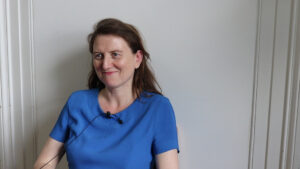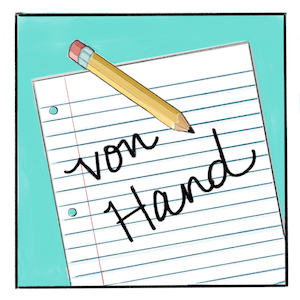In dieser Lektion
Lesen
Claudia David beschreibt ihre Familie:
Eine sehr interessante Familie habe ich. Meine Mutter ist Ägypterin und mein Vater ist Palästinenser—da fängt der Spaß an! Obwohl sie die gleiche Sprache haben, Arabisch, ist der Dialekt anders. Ich habe drei Geschwister. Sie sind alle verheiratet und ich habe viele Nichten und Neffen. Sie haben mich eine stolze Tante gemacht! Wir sind super divers—eine Mischung haben wir in unserer Familie. Es gibt Leute aus Österreich, es gibt Leute aus Syrien, aus Ägypten, und die Kinder sind teilweise in Österreich geboren, andere sind in Deutschland geboren. Wir haben deutsche Kinder und österreichische Kinder, auch von der Nationalität her. Ein Bruder von mir hat zwei Töchter, die eine ist Österreicherin, die andere ist Deutsche. Ein Teil von der Familie wohnt in Wien—in Österreich—und ein Teil wohnt in Deutschland.
Arbeit mit dem Lesen 1
Anna beschreibt ihre Familie:
 Ich selbst habe keine Kinder, aber ich habe sehr viele Freunde. Also meine Freunde sind meine konstante Familie. Einer meiner Ex-Freunde, mit dem ich 11 Jahre zusammen war, ist neu liiert, und mit seiner neuen Partnerin ist er 12 Jahre zusammen. Sie haben zusammen ein Kind. Die Tochter ist jetzt 11. Wir feiern immer gemeinsam Ostern und manchmal auch Weihnachten. Das ist auch eine Familie für mich. Wir sind befreundet und wir verstehen uns auch gut.
Ich selbst habe keine Kinder, aber ich habe sehr viele Freunde. Also meine Freunde sind meine konstante Familie. Einer meiner Ex-Freunde, mit dem ich 11 Jahre zusammen war, ist neu liiert, und mit seiner neuen Partnerin ist er 12 Jahre zusammen. Sie haben zusammen ein Kind. Die Tochter ist jetzt 11. Wir feiern immer gemeinsam Ostern und manchmal auch Weihnachten. Das ist auch eine Familie für mich. Wir sind befreundet und wir verstehen uns auch gut.
Arbeit mit dem Lesen 2
Strukturen
Personal Pronouns and the verb haben
You already learned most of the forms of the verb haben. But now let’s expand that knowledge and add the forms for three more pronouns, wir (=we), ihr (=informal you, plural), and sie (=they). Sie (=they) is always the same form as Sie (=formal you), so that makes life easier. Note that the formal you form is always capitalized: Sie.
| singular | plural | ||
|---|---|---|---|
| ich | habe | wir | haben |
| du | hast | ihr | habt |
| Sie | haben | Sie | haben |
| sie/es/er xier/they | hat | sie | haben |
A note about du, ihr, and Sie
In English, we have only one word for you, but in German there are three ways to say you : Sie, du and ihr. Sie (always capitalized to show respect) is the formal form, and you use it with people you don’t know, people who are older than you, and people in positions of authority. Sie is both singular and plural, which means you can use it to refer either to one person or to more than one person. Du is the informal form of you. It is used to refer to fellow students, to close friends, and to children. Ihr is the plural form of du—so you can use it to refer to a group of friends or children, for example. Ihr is like “ya’ll” or “you all”—informal and plural.
Note that sie when not capitalized can mean either she or they. Thus, you need to pay attention to the verb form and the context in order to figure out who is being referenced. Here is a table with all of the pronouns:
| singular | plural |
|---|---|
| ich (I) | wir (we) |
| du (you, informal) | ihr (you, informal) |
| Sie (you, formal) | Sie (you, formal) |
| sie (she) es (it) er (he) | sie (they) |
| xier (non-gendered) they (non-gendered) | |
Regular verbs and haben
Just like in most languages, German has some verbs that are regular, meaning they follow a predictable conjugation pattern, and verbs that are irregular, meaning that they change in less predictable ways. Haben is an example of an irregular verb, although it follows much of the regular pattern. Wohnen is an example of a regular verb. Here’s how it’s conjugated:
| singular | plural | ||
|---|---|---|---|
| ich | wohne | wir | wohnen |
| du | wohnst | ihr | wohnt |
| Sie | wohnen | Sie | wohnen |
| sie/es/er xier/they | wohnt | sie | wohnen |
The base form of the verb is called the infinitive, like wohnen or machen, and it is translated into English as “to live” or “to do.” To conjugate the verb, you need the verb stem, which is what you get when you take the “-en” off the end of the verb: “wohn-“. Then you add the following endings:
ich -e
du -st
sie/es/er/xier -t
wir -en
ihr -t
Sie/sie -en
Or, in table form, it looks like this:
| singular | plural | ||
|---|---|---|---|
| ich | -e | wir | -en |
| du | -st | ihr | -t |
| Sie | -en | Sie | -en |
| sie/es/er xier/they | -t | sie | -en |
Note just a few special circumstances here:
- If the stem of a verb ends in a “d” or “t”, then add an “e” before the “-t” or “-st” ending. Example: arbeiten (to work). The verb stem is arbeit-, so the du-form is arbeitest and the sie/er/es form is arbeitet.
- If the stem of a verb ends in s or ss, then you don’t add an additional s for the du form. Example: heißen. The verb stem is heiß-, so the du-form ist heißt. Notice that the du-form and the er/sie/es/xier-form are thus the same: es heißt.
Review the forms of the regular verbs and of haben. Then test your learning with the quiz that follows.
| singular | plural | ||
|---|---|---|---|
| ich | habe | wir | haben |
| du | hast | ihr | habt |
| Sie | haben | Sie | haben |
| sie/es/er xier/they | hat | sie | haben |
| singular | plural | ||
|---|---|---|---|
| ich | wohne | wir | wohnen |
| du | wohnst | ihr | wohnt |
| Sie | wohnen | Sie | wohnen |
| sie/es/er xier/they | wohnt | sie | wohnen |
Schreiben

Write sentences using “haben” and “wohnen” to describe Claudia’s and Anna’s family.
Hören
Strukturen
Direct Objects
You learned the forms ein and eine, and der and die, but you’ve probably noticed that you sometimes see forms like einen or einem or den or dem. That’s because in German the article may change to reflect the role that its noun plays in the sentence. Thus we have forms that are for the subjects of the sentence (ein or eine) and some forms that are for the direct objects of a sentence (einen, eine, or ein).
What is a direct object? A direct object is the thing that receives the action in a sentence. Take for example the sentence “I have a sister.” I is the subject of the sentence; it is doing the action (having, in this case). The sister is the direct object of the sentence, because it is being acted upon. Let’s look at another example: I kick the ball. “I” is the subject because it is doing the action. What am I doing? I am kicking. And what am I kicking? I’m kicking the ball, which is the direct object.
The form for the subject is called the nominative case. The form for the direct object is called the accusative case. Here’s how these forms shift in German:
| Pl. | die | das | der | |
|---|---|---|---|---|
| Nominativ | die Eltern | die Schwester | das Kind | der Bruder |
| Akkusativ | die Eltern | die Schwester | das Kind | den Bruder |
Schreiben

Was haben Sie in Ihrer Familie? Beschreiben Sie Ihre Familie! Verwenden Sie den Wortschatz unten.
Wortschatz
Nouns
der Bruder, -¨
der Cousin, -s (or der Vetter, -)
die Cousine, -n (or die Kusine, -n)
die Eltern (plural)
die Familie, -n
der Familienstammbaum, -¨
das Familienmitglied, -er
die Frau, -en
das Geschwister, – (usually used in the plural: die Geschwister)
die Großeltern (plural)
die Großmutter, -¨ (oder die Oma, -s)
der Großvater, -¨ (oder der Opa, -s)
die Herkunftsfamilie, -n
der Junge, -n
die Kernfamilie, -n
das Kind, -er
das Mädchen, –
der Mann, -¨er
das Mitglied, -er
die Mutter, -¨
der Neffe, -n
die Nichte, -n
der Onkel, –
der Partner, –
die Partnerin, -nen
die Schwester, -n
der Sohn, -¨e
die Tante, -n
die Tochter, -¨
der Vater, -¨
Verbs
beschreiben
haben
wohnen
Adjectives and Adverbs
alt
befreundet
geboren
gestorben
jung
liiert
mütterlich
väterlich
verheiratet
verstorben
zusammen
Other Useful Words and Phrases
älter
jünger